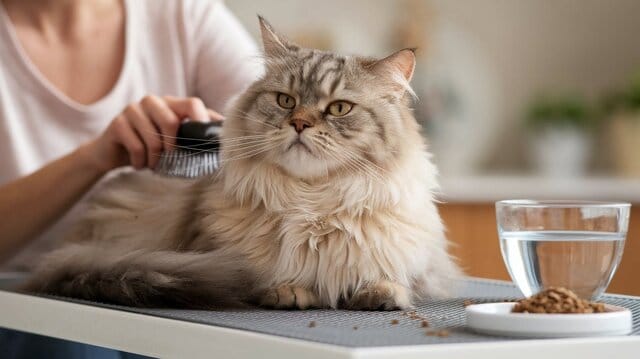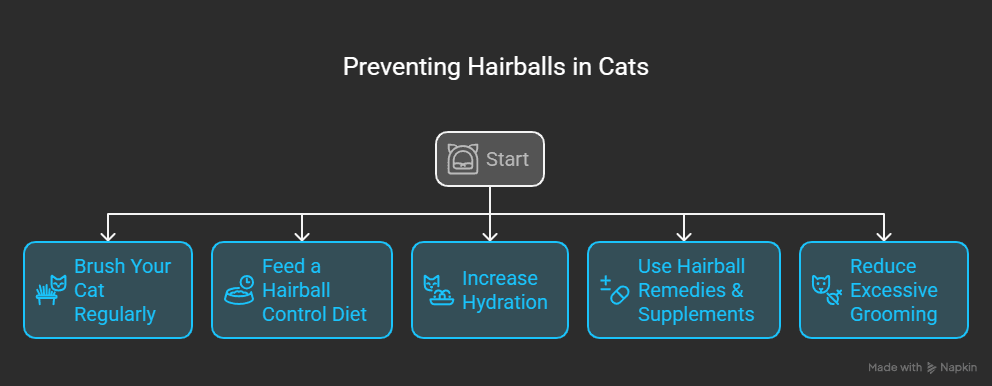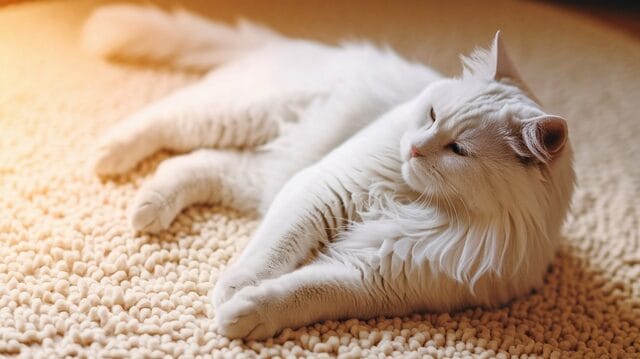
Introduction
If you’ve ever heard your cat making that weird gagging sound, you probably knew what was coming—a hairball. It’s not exactly a pleasant experience for either of you. One minute, your cat is happily grooming, and the next, they’re hacking up a wet clump of fur on your favorite rug. That’s why it’s important to know how to prevent hairballs in cats before they become a messy routine.
While hairballs are a normal part of being a cat, too many can indicate an underlying issue. The good news? You can reduce hairballs with the right care and diet adjustments.
Let’s dive into why cats get hairballs, how to prevent them, and some effective home remedies to keep your cat hairball-free.
Why Do Cats Get Hairballs?
Cats are fastidious groomers—they spend hours licking their fur each day. When they groom, their rough tongues pick up loose hair, which they inevitably swallow.
Most of this swallowed hair passes naturally through their digestive system, but sometimes, it forms a clump in the stomach. When this happens, your cat will cough it up as a hairball.
Some Cats Are More Prone to Hairballs Than Others
🐾 Long-haired breeds (Persians, Maine Coons) swallow more fur = more hairballs.
🐾 Older cats groom more efficiently than kittens = more hairballs.
🐾 Excessive groomers (due to stress or boredom) may produce more hairballs.
If your cat is coughing up hairballs frequently, it’s time to take action!
How to Prevent Hairballs in Cats: 5 Proven Strategies

1. Brush Your Cat Regularly (Reduce Loose Fur)
One of the simplest ways to prevent hairballs is to remove excess fur before they swallow it. The less loose hair your cat ingests, the fewer hairballs they’ll produce.
✔ Short-haired cats: Brush 2-3 times per week.
✔ Long-haired cats: Brush daily to keep shedding under control.
🔹 Best Brushes for Hairball Prevention: – FURminator Deshedding Tool (removes deep undercoat fur).
– Slicker Brushes (great for long-haired cats).
2. Feed a Hairball Control Diet
Certain cat foods are formulated with extra fiber to help move hair through the digestive tract before it forms a hairball.
✔ Look for “Hairball Control” labeled cat food.
✔ Choose high-fiber, grain-free options for easier digestion.
🔹 Best Hairball Control Cat Foods: – Hill’s Science Diet Hairball Control – Blue Buffalo Indoor Hairball & Weight Control
3. Increase Hydration (Water Helps Digestion!)
Cats are not big water drinkers, but hydration is key for healthy digestion. More water = easier hair movement through their digestive system.
✔ Use a cat water fountain (cats prefer running water).
✔ Add wet food to their diet for extra moisture.
✔ Keep multiple water bowls around the house.
4. Use Hairball Remedies & Supplements
If your cat is still coughing up hairballs despite brushing and diet changes, try a hairball remedy.
✔ Hairball gels & laxatives: These contain lubricants like petroleum jelly or malt to help hair pass through the intestines.
✔ Pumpkin puree: A teaspoon of plain, unsweetened pumpkin adds fiber and aids digestion.
✔ Cat grass: Some cats eat grass to naturally induce vomiting and clear their stomachs.
🔹 Best Hairball Remedies for Cats: – Tomlyn Laxatone Hairball Remedy – Vet’s Best Hairball Relief Digestive Aid
5. Reduce Excessive Grooming (If Your Cat is Over-Grooming)
If your cat grooms excessively, they’re swallowing more hair than usual. Over-grooming is often caused by:
🐾 Stress or anxiety (changes in environment, new pets).
🐾 Skin allergies or irritation (leading to obsessive licking).
✔ Provide interactive toys to keep them mentally stimulated.
✔ Use pheromone diffusers (like Feliway) to reduce stress.
✔ Check for fleas or allergies if grooming seems excessive.
Home Remedies for Cat Hairballs
If you prefer natural solutions, try these home remedies:
✔ Pumpkin (Fiber Boost) – A teaspoon of plain canned pumpkin aids digestion.
✔ Olive Oil or Coconut Oil – A small amount lubricates hair to help it pass.
✔ Psyllium Husk or Metamucil – Extra fiber for digestion (ask your vet for dosage).
When to See a Vet: Hairball Danger Signs
🚨 While occasional hairball is normal, too many could be a sign of a serious problem.
🔴 Frequent gagging without producing a hairball.
🔴 Loss of appetite or vomiting undigested food.
🔴 Constipation or difficulty passing stool.
🔴 Lethargy or bloated stomach.
If your cat shows any of these symptoms, visit a vet ASAP to rule out a possible blockage.
🙋 FAQs
Q1: Is hairball dangerous for cats?
✔ Occasionally? No.
✔ Frequent hairballs? Could indicate a blockage—consult a vet.
Q2: How often should I give my cat hairball remedies?
✔ Most gels/supplements can be given 2-3 times per week (check the label).
Q3: Do all cats get hairballs?
✔ No! Some cats never get hairballs, while others get them often. It depends on their grooming habits and fur type.
Q4: Can kittens get hairballs?
✔ Rarely, since kittens groom less than adult cats.
Also Read - How to Train a Cat? 5 Easy Tricks Every Cat Owner Should Try
Final Thoughts: Keep Your Cat Hairball-Free!
Hairballs may be a normal part of cat life, but too many can indicate a problem. Thankfully, with simple diet changes, regular brushing, and hydration, you can greatly reduce the number of hairballs your cat experiences.
🐱 Now It’s Your Turn!
Does your cat get hairball often? What remedies have worked for you? Share your experience in the comments below! 👇🐾




